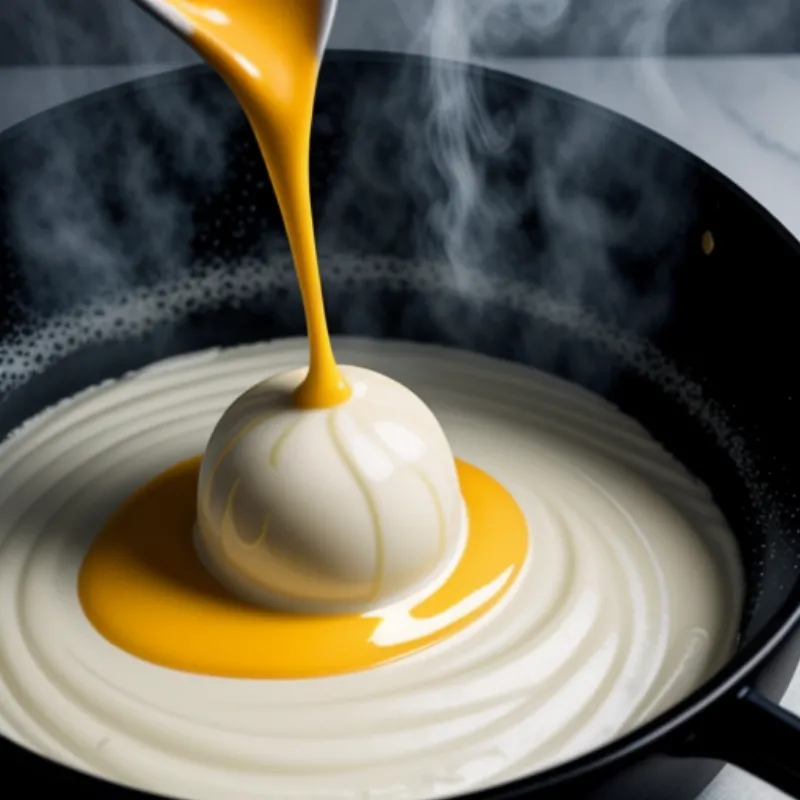Hollandaise sauce, the velvety-smooth, buttery delight, is a staple in French cuisine, often gracing the likes of poached eggs Benedict and perfectly steamed asparagus. While its reputation might intimidate some home cooks, fear not! This comprehensive guide will demystify the process and equip you with the knowledge to make a perfect Hollandaise sauce right in your own kitchen.
Imagine the creamy texture, the rich buttery flavor, and the subtle tang that tantalizes your taste buds. It’s no wonder that this classic sauce has stood the test of time. Whether you’re a seasoned chef or just starting your culinary journey, this foolproof recipe will guide you every step of the way.
Mastering the Art of Hollandaise: A Step-by-Step Guide
Ingredients: What You’ll Need
Essentials:
- 3 large egg yolks (ensure they’re at room temperature for optimal emulsification)
- 1 tablespoon freshly squeezed lemon juice (about half a lemon)
- 1/4 teaspoon salt (or to taste)
- Pinch of cayenne pepper (optional, for a hint of heat)
The Star of the Show:
- 1 stick (113 grams) unsalted butter, melted and still warm (clarified butter, if you prefer a richer sauce)
Don’t Forget the Tools:
- Double boiler or a heatproof bowl and saucepan
- Whisk
- Small saucepan
Let’s Get Cooking!
Step 1: The Foundation
- Fill the bottom of your double boiler or saucepan with a couple of inches of water and bring it to a gentle simmer. Avoid boiling, as excessive heat can scramble the egg yolks.
Step 2: Whisking to Emulsification
- In the top part of the double boiler or the heatproof bowl, combine the egg yolks, lemon juice, salt, and cayenne pepper (if using).
- Place the bowl over the simmering water, making sure the bottom doesn’t touch the water.
- Now, whisk vigorously! This is crucial for creating a smooth, emulsified sauce. Continue whisking for about 5-7 minutes, or until the mixture lightens in color and thickens enough to coat the back of a spoon.
Step 3: The Butter Trickle
- Here’s the trickiest part: slowly drizzle the melted butter into the yolk mixture while whisking constantly. Don’t rush this step. A thin, steady stream is key to a successful emulsion. If the sauce starts to look too thick, add a teaspoon of warm water.
Step 4: Seasoning and Serving
- Once all the butter is incorporated, taste your Hollandaise and adjust the seasoning as needed. Add a pinch more salt, a squeeze of lemon, or a touch more cayenne to your liking.
- Serve immediately over your favorite dishes.
 Perfect Hollandaise Sauce
Perfect Hollandaise Sauce
FAQs: Your Hollandaise Queries Answered
Q: My sauce is too thick! What can I do?
A: Don’t worry; it happens! Gradually whisk in warm water, a teaspoon at a time, until you reach the desired consistency.
Q: Help! My sauce curdled! Can I fix it?
A: Don’t panic; there’s still hope! Remove the sauce from the heat immediately. Vigorously whisk in a tablespoon of cold water to stop the cooking process. If it’s still curdled, try whisking in an ice cube.
Q: Can I make Hollandaise ahead of time?
A: For the best results, Hollandaise is best served fresh. However, you can make it up to two hours in advance. Store it in a heatproof bowl set over a pot of barely simmering water, making sure the bottom of the bowl doesn’t touch the water.
Tips from a Culinary Expert
Chef Pierre, a renowned chef specializing in French cuisine, suggests using clarified butter for a richer, more intense flavor. He also recommends adding a teaspoon of Dijon mustard to the yolk mixture for an extra layer of complexity.
Beyond the Benedict: Serving Your Masterpiece
While Hollandaise sauce is famously paired with Eggs Benedict, its versatility extends far beyond. Consider these delectable options:
- Asparagus: Drizzle it over steamed or grilled asparagus for an elegant side dish.
- Salmon: Serve it atop grilled or poached salmon for a restaurant-quality meal.
- Vegetables: Elevate your steamed vegetables with a generous spoonful of Hollandaise.
 Hollandaise Sauce on Asparagus
Hollandaise Sauce on Asparagus
Storing Your Hollandaise
If you have any leftovers (though unlikely!), store them in an airtight container in the refrigerator for up to two days. Gently reheat it over low heat, whisking constantly, before serving.
Conclusion: Embrace the Hollandaise Challenge
Making Hollandaise sauce is a culinary rite of passage. Armed with this comprehensive guide, you’re now ready to conquer this classic sauce. So, gather your ingredients, put on your apron, and embark on your Hollandaise-making adventure! Don’t forget to share your culinary triumph with us in the comments below. We’d love to hear about your Hollandaise experience!
For more delicious sauce recipes and culinary adventures, explore our website and discover a world of flavor! Interested in other French sauces? Check out our guides on how to make Béarnaise sauce or Sauce Choron.
